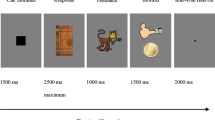Abstract
Attention deficit (ADDH) children self-paced the delivery of response pairs for paired-associate learning at about the rate previously shown to be conducive to relatively good learning in attention deficit. The self-pacing opportunity did not seem either to impair or to enhance the learning performance. On methylphenidate they paced themselves at about the same rate but learned much more. Stimulant therapy does not help by “slowing the child down” but permits more effective memorizing at the same presentation rate.
Similar content being viewed by others
References
American Psychiatric Association. (1968).Diagnostic and statistical manual of mental disorders (2nd ed.) Washington, DC: Author.
Broadbent, D. E. (1953). Noise, paced performance and vigilance tests.British Journal of Psychology, 44, 295–303.
Bugelski, B. R. (1962). Presentation time, total-time and mediation in paired-associate learning.Journal of Experimental Psychology, 63, 405–412.
Campbell, S. B., & Werry, J. S. (1986). Attention deficit disorder (hyperactivity). In H. C. Quay & J. S. Werry (Eds.),Psychopathological disorders of childhood (3rd ed., pp. 111–155). New York: Wiley.
Conte, R., Kinsbourne, M., Swanson, J. M., Zirk, H., & Samuels, M. (1986). Presentation rate effects on paired associate learning by attention deficit disordered children.Child Development, 57, 681–687.
Dalby, J. T., Kinsbourne, M., Swanson, J. M., & Sobol, M. P. (1977). Hyperactive children's underuse of learning time: Correction by stimulant treatment.Child Development, 48, 1448–1453.
Kappauf, W. S., & Powe, W. E. (1959). Performance decrement in an audio-visual checking task.Journal of Experimental Psychology, 57, 49–56.
Kinsbourne, M. (1983). Toward a model for the attention deficit disorder. In M. Perlmutter (Ed.),The Minnesota symposia on child psychology (P. 137–166). Hillsdale, NJ: Erlbaum.
Kinsbourne, M., Deutsch, C. K., Fiore, C., & Rosenberger, P. B. (1989).Determinants of effective attention in attention deficit. Manuscript in preparation.
Schroyer, C., & Zentall, S. S. (1986). Effects of rate, nonrelevant information, and repetition on the listening comprehension of hyperactive children.Journal of Special Education, 20, 231–239.
Stevenson, H. W. (1972).Children's learning. New York: Meredith.
Swanson, J. M., & Kinsbourne, M. (1976). Stimulant related state-dependent learning in hyperactive children.Science, 192, 1754–1755.
Swanson, J. M., Kinsbourne, M., Roberts, W., & Zucker, K. (1978). A time-response analysis of the effect of stimulant medication on the learning ability of hyperactive children.Pediatrics, 61, 21–29.
Sykes, D. H., Douglas, V. I., Weiss, G., & Minde, K. K. (1971). Attention in hyperactive children and the effect of methylphenidate (Ritalin).Journal of Child Psychology and Psychiatry, 12, 129–139.
Zacks, R. (1969). Invariance of total learning time under different conditions of pacing.Journal of Experimental Psychology, 82, 441–447.
Zentall, S. (1975). Optimal stimulation as theoretical basis of hyperactivity.American Journal of Orthopsychiatry, 45, 549–563.
Zentall, S. S. (1986). Effects of color stimulation on performance and activity of hyperactive and nonhyperactive children.Journal of Educational Psychology, 78, 159–165.
Author information
Authors and Affiliations
Rights and permissions
About this article
Cite this article
Dalby, J.T., Kinsbourne, M. & Swanson, J.M. Self-paced learning in children with attention deficit disorder with hyperactivity. J Abnorm Child Psychol 17, 269–275 (1989). https://doi.org/10.1007/BF00917398
Revised:
Issue Date:
DOI: https://doi.org/10.1007/BF00917398




